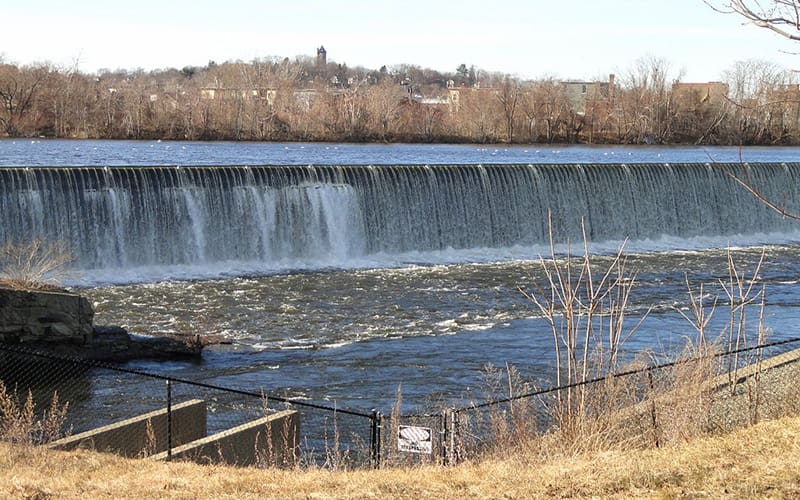
Great Stone Dam in Lawrence, MA, where canal infrastructure is crumbling due to corporate neglect.
This is the third and last blog entry in a series on issues surrounding the dilapidated canal infrastructure in Lawrence, Massachusetts. Look for more from Rafael Mares in the coming months. To stay up to date, visit www.clf.org/blog/tag/lawrence-canals-series or follow the hashtag #RestoreLawrenceCanals on Twitter.
Lawrence’s troubled canals are part of a larger infrastructure complex that includes a hydroelectric dam that today harnesses water from the powerful flow of the Merrimack River, just as the city’s textile mills and factories did a century ago. The entire facility is owned by Enel Green Power North America Inc.
But Enel has neglected its responsibility to its community neighbors by allowing the canals to fall into decay and disrepair. The company’s obligation to keep the canals in good working order is also a legal one – it’s a requirement of the federal license it received to run its hydroelectric plant in 1978.
This neglect has turned the canals into a blight on a city that is working hard to revitalize its riverfront neighborhoods and its economy.
Enel Has Failed in Its Community Obligation…
Residents and community leaders have taken their concerns about the condition of the canals directly to Enel on countless occasions. They’ve also complained repeatedly to local agencies to try to get the company and its subsidiaries to repair and maintain the canal infrastructure.
But with years of tireless efforts to convince Enel to live up to its responsibilities having proved unsuccessful, a group of canal abutters and community organizations have decided to seek help from a federal agency. Led by CLF and the City of Lawrence, the group, which includes Groundwork Lawrence, Lawrence CommunityWorks, and canal abutters, filed a complaint on June 7, 2017, with the Federal Energy Regulatory Commission (FERC) seeking action against the owners and operators of the hydroelectric plant for failing to comply with the terms of its license.
…And in Its Legal Obligation to Care for Lawrence’s Canals
FERC is an independent federal regulatory agency that issues and enforces licenses to operate hydroelectric facilities. The license for the facility in Lawrence, among other obligations, requires Enel and its subsidiaries to avoid any adverse impact on historical structures, maintain and perpetuate the cultural and historic character of the area, and operate the project in a manner that duplicates the historical operation. The company is also required to prevent soil erosion and water pollution around the facility and regularly clear any waste or obstructions from the canals. Finally, the license instructed Enel to build and maintain recreational facilities along the canal, provide public access to the area and waters, and generally ensure the aesthetic integrity and state of good repair of the canal infrastructure – including sustaining a minimum flow of water.
Enel and its subsidiaries have violated all of these provisions.
The list of license violations easily fills more than 20 pages. Some of these violations will be relatively simple to address with regular upkeep. For example, instead of occasionally agreeing to sponsor volunteer cleanups initiated and run by a community group, Enel should regularly and professionally remove garbage from the canal. Other violations, due to years of neglect, require more work, such as repairing the canal walls.
Historic Structures Left to Decay
Enel’s unwillingness to uphold its responsibilities, however, may best be epitomized by its approach to historic preservation. Long before any application for a hydroelectric project was ever filed, the North and South Canals in Lawrence were respectively listed and eligible for listing on the National Register of Historic Places. The license therefore included specific historic preservation requirements to not only protect the North and South Canals, but also enhance the public enjoyment of their cultural and historic significance.
Despite the FERC’s clear directions, Enel has violated and continues to violate each of these license requirements, allowing these important historic structures to severely deteriorate. Without regard to the impact on the historic canal infrastructure, Enel has lowered the water level of the canals, exposing both wooden and masonry components to air, freeze and thaw cycles, and the invasion of vegetation, which in turn has resulted in leaks. As a result, canal walls are collapsing, wooden infrastructure is rotting, and embankments are eroding.
The City of Lawrence, CLF, and its partners have set out to solve these problems. The goal of the complaint filed with FERC is to end Enel’s practice to take poetic license with its hydroelectric license and finally make the canals a vibrant area for walking, running, biking, and boating and a draw for the City of Lawrence.



